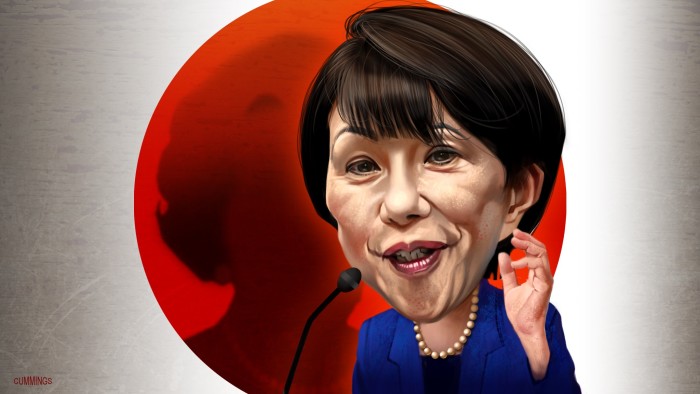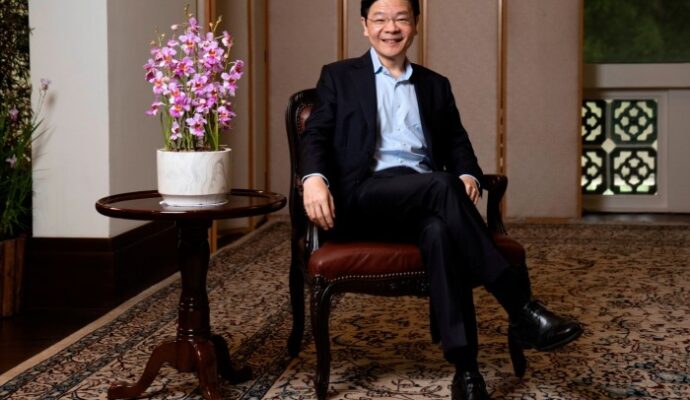
Unlock the Editor’s Digest for free
Roula Khalaf, Editor of the FT, selects her favourite stories in this weekly newsletter.
In a brief bit of footage from the early 1990s, a young, power-suited Sanae Takaichi speeds past Japan’s parliament building in the back seat of a limousine. She hoists dumbbells in a commanding office above Tokyo. She strides determinedly up escalators, while others stand passively.
“I felt I had found what I truly wanted to do,” says the future prime minister describing her recent political awakening while interning for a US congresswoman. “Having observed Japan from the American Congress, I became determined to work for Japan!”
The video fades into the logo of Daishinpan, a long-forgotten credit card company that Takaichi, then a television news presenter, was advertising at the time. Inadvertently, the commercial captures a historic moment of transformation: imprinting on the public consciousness the picture of a woman at the start of a 30-year ascent to Japan’s highest political office.
Takaichi’s current status as an emblem of transformation finds Japan in a period of painful flux. Inflation, so long absent from household calculations, is now a make-or-break political issue. The Liberal Democratic party, in power for most of the past 70 years, is in survival mode. Japan’s closest ally, the US, has become unpredictable. Takaichi, whose arch-conservatism on social issues makes her naturally divisive but who has sky-high approval ratings, must play the role of unifier in a fragmenting world.
And, despite many attempts to do so, Japan’s “iron lady” herself is hard to place. Her inauguration this week as the country’s 104th prime minister, was born of both meticulous planning on her part and the chaos of a ruling party in crisis. Many previous prime ministers drifted into the job; Takaichi appears to have wanted it forever. Her rise to the top, hailed by some as a breakthrough for Japanese women, has invited criticism that her demeanour is too masculine and done much to lay bare the absence of any supportive sisterhood. In a postwar political environment where prime ministers last an average of two years, her chances of longevity are low; Takaichi’s power to prevail, however, has been consistently underestimated.
Her ascent to the presidency of the patrician, male-dominated LDP is both natural, because she is a fervent nationalist and a staunch conservative, and astonishing as a self-made woman from an ordinary working family. The 64-year-old’s image as a tireless “zero work-life balance” toiler is both carefully crafted and entirely genuine.
Takaichi was born into a traditionalist family in the ancient capital of Nara who saw no reason why a girl should attend university. When she insisted she must, they insisted she continue to live at home while attending. As a politician, she has maintained the values of middle-class conservative Japan, with an extra dollop of nationalism. She takes a revisionist view of Japan’s history, for example, inviting concern that her visits to the controversial Yasukuni shrine will continue as prime minister — potentially disrupting relations with China and South Korea.
Much has been made of Takaichi’s love of heavy metal music and the fact that she once rode a motorbike. The truer signal of rebellion, say people who know her well, was her idolisation of Margaret Thatcher. “I think that people have somewhat misunderstood her admiration for Thatcher,” says one friend. “She likes the Iron Lady image but it’s a lot deeper than that”. In Britain’s first female prime minister, Takaichi saw someone both traditionalist and driven to upset what conservatives expected of her.
Like Thatcher, Takaichi is doomed, said the same person, to make as many enemies as admirers. One of her first acts was to put a minister “in charge of a society of well-ordered and harmonious coexistence with foreign nationals”. Some will see this as evidence of xenophobia; others will applaud a measure that might have spared other countries the sort of immigration-related frictions that many Japanese fear.
“She has been quietly surprising people for a long time,” says one person within the LDP. “I don’t think that will stop now.”
People have complained, for example, that she has no clear policy core. But she has already published, with the LDP’s new coalition partner, an extensive eight-page statement of policy goals that comes closer to being a manifesto than anything the party has done before.
Takaichi’s political career was, to a significant extent, propelled by the late Shinzo Abe — himself a nationalist from the right wing of the party who became Japan’s longest-serving prime minister. Takaichi twice served as minister in his cabinets. Her premiership has invited both political and market speculation that she will attempt to revive Japan’s fortunes through her own brand of the stimulus and structural reform known as Abenomics.
Comparisons with Abe are useful, but not necessarily predictive. For all his nationalist and rightwing credentials, pragmatism pulled Abe firmly towards the centre. Many wonder whether the same will happen to Takaichi, and if so, how strong that pull will be. Italy’s arch conservative — and first female — prime minister, Giorgia Meloni, whose hardline positions on several key issues have been shifted by pragmatism, has started to look like a potentially useful guide to Takaichi’s future. Meloni, in another country with a legacy of rapidly defenestrated leaders, has survived for three years and is still going strong. Takaichi has made history once; she has plenty of scope to do so again.


